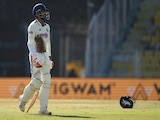- INS Himgiri and INS Udaygiri, two Nilgiri-class stealth frigates, were commissioned by Rajnath Singh
- The frigates have over 75% indigenous content and are part of Project 17 Alpha (P-17A)
- Himgiri was built in Kolkata and Udaygiri in Mumbai, marking dual commissioning from two shipyards
The Navy on Tuesday commissioned two new Nilgiri-class stealth frigates - INS Himgiri and INS Udaygiri - in a ceremony presided over by Defence Minister Rajnath Singh.
The two 'made-in-India' warships are a part of the Project 17 Alpha (P-17A).
The lead vessel, INS Nilgiri, was commissioned earlier this year. The Himgiri and Udaygiri are largely homegrown - with over 75 per cent indigenous content - and represent a big boost to the government's 'aatmanirbharta', or self-reliance, push in defence manufacturing and capabilities.
This is the first time two major warships from two prestigious shipyards are being commissioned at the same time; Himgiri was built Garden Reach Shipbuilders and Engineers in Kolkata and Udagiri by Mumbai's Mazagon Dock Shipbuilders. Sources told NDTV this dual commissioning shows India's growing shipbuilding prowess and synergy between premier defence shipyards.
With this, India now also has a three-frigate squadron demonstrating the country's industrial-technological capability and regional power balance by indigenous capability.
A statement said Udaygiri and Himgiri contain big improvements in design, stealth, weapon and sensor systems, and are capable of executing a full spectrum of maritime missions. Their commissioning augments the Navy's combat readiness, the official statement said.
Udaygiri also holds the distinction of being the fastest ship in this class to be delivered post-launch, a result of the modular construction methodology adopted by Indian shipyards.
Both were designed by the Navy's Warship Design Bureau; in fact, Udaygiri is the 100th ship to be designed by the WDB. And they have been named for predecessors that served the nation with distinction for over 30 years before being recently decommissioned..
Post-commissioning, the two frigates will join the Eastern Fleet, strengthening India's ability to safeguard its maritime interests across the Indian Ocean Region.
The two ships represent a generational leap over earlier designs.
Displacing about 6,700 tons each, the P-17A frigates are roughly five per cent larger than the earlier Shivalik-class frigates but incorporate a sleeker form and a reduced radar cross-section.
All About INS Udaygiri
- Manufactured by Mumbai-based Mazagon Dock Shipbuilders
- It is 149 meters long with a top speed of 28 knots, i.e., about 52 km per hour
- Weapons include 48 Barak-8 missiles and eight BrahMos supersonic missiles
- Can operate two helicopters
They are powered by diesel engines and gas turbines that drive controllable-pitch propellers and are managed through an integrated management interface.
All About INS Himgiri
- Manufactured by Kolkata-based Garden Reach Shipbuilders
- Same length, weight, and top speed as Udaygiri, and can also carry two helicopters
- Weapons include 32 Barak-8 missiles and eight BrahMos supersonic missiles
- Also has the Mareech torpedo decoy system
Each of the ships also carries other weapons, including supersonic surface-to-surface missiles, medium-range surface-to-air missiles, a 76 mm MR Gun, and a combination of 30 mm and 12.7 mm close-in weapon systems, as well as anti-submarine/underwater weapon systems.
Indo-Pacific, Maritime Security Role
The key challenge for India is China's growing maritime expansion, which has established its hold in Gwadar (Pakistan), Hambantota (Sri Lanka), Chittagong (Bangladesh), and Djibouti under the 'string of pearls' policy. In such a situation, the Nilgiri class frigates would act as a strong deterrent for India.
Officials said that the frigates would not only protect the sea trade routes, but also make India's naval presence credible in the Indian Ocean region from the Strait of Malacca to Africa.















